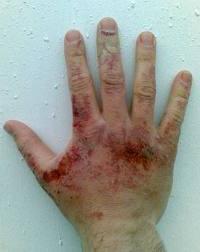Sodium hydroxide, or caustic soda - inorganica compound that belongs to a class of bases, or hydroxides. Also in technology and abroad this substance is called caustic soda. Trivial name - caustic soda - it got because of its strong corrosive effect.

When dissolved in water, it forms an active substance- alkali, - soap-to-touch. This reaction proceeds very rapidly - with spattering and release of heat. It is the ingestion of alkali on the skin and mucous causing severe chemical burns, so when working it is necessary to be careful and protect your hands and eyes. If this substance gets on the epithelium or in the eyes, mouth, it is necessary to rinse the affected areas with water and a weak solution of acetic (2%) or boric (3%) acid as soon as possible and then again with water. After providing emergency care, the victim should be shown to the doctor.
Sodium hydroxide (formula of a chemical compound- NaOH, stratura - Na-O-H) is a reactive substance that can react with both inorganic and organic substances. To detect it in aqueous solutions will help a qualitative reaction to the hydroxide ion with various indicators. Thus, the litmus indicator becomes dark blue, methyl orange - yellow, and phenolphthalein - crimson, while the intensity of color will depend on the concentration of alkali.
Sodium hydroxide enters into such reactions:

1.neutralization with acids, acid oxides and amphoteric compounds. The result of this reaction is the formation of water and salt or hydroxo-complex - in the case of interaction with amphoteric bases and oxides;
2. exchange with salts;
3. with metals that are up to hydrogen in the Beketov series and have a low electrochemical potential;
4. with non-metals and halogens;
4. hydrolysis with esters;
5. Saponification with fats (soap and glycerin are formed);
6. interactions with alcohols (substances alcoholates are formed).

Also in the molten form, sodium hydroxide can destroy porcelain and glass, and with access to oxygen - noble metal (platinum).
Sodium hydroxide can be obtained by such methods:
- electrolysis of aqueous NaCl solution (diaphragm and membrane method),
- chemical (calcareous and ferritic method).
In recent years, methods based on electrolysis have been used most often, since they are more profitable.
Caustic soda uses a largepopularity and is used in many industries - cosmetic, pulp and paper, chemical, textile, food. It is used as an additive Е-524, for degassing of premises and for obtaining biodiesel fuel.
Thus, sodium hydroxide is an alkali, which has found wide application in various branches of human economic activity due to its chemically active nature.





